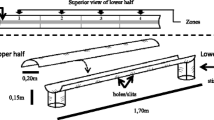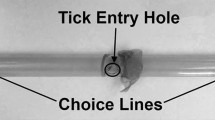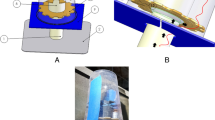Abstract
The response of mated naive Ixodiphagus hookeri females to cattle and Amblyomma variegatum nymphal odors was tested in a Y-tube olfactometer. I. hookeri females were attracted to cattle urine, dung, and odors from tick-free feeding sites of A. variegatum nymphs on cattle, e.g., dewlaps, front heels, and hind heels. Tick-free scrotal odors did not attract the parasitoids. Furthermore, odors from off-host unfed and fed A. variegatum nymphs did not attract the parasitoids, despite an increase in the number of the nymphs to amplify any odor signal. A blend of odors from feeding on-host nymphs and cattle scrota attracted the parasitoids. In T-tube bioassays, I. hookeri females were attracted to hexane washes and fecal extracts of A. variegatum nymphs.
Similar content being viewed by others
REFERENCES
Agelopoulos, N. G., Dicke, M., and Posthumus, M. A. 1995. Role of volatile infochemicals emitted by feces of larvae in host-searching behaviour of the parasitoid Cotesia rubecula (Hymenoptera: Braconidae): A behavioural and chemical study. J. Chem. Ecol. 16:1789–1811.
Alborn, H. T., Lewis, W. J., and Tumlinson, J. H. 1995. Host-specific recognition kairomone for the parasitoid Microplitis croceipes (Cresson). J. Chem. Ecol. 21:1697–1708.
Apps, P. J., Viljoen, H. W., and Pretorius, V. 1988. Aggregation pheromones of the bont tick Amblyomma hebraeum: Identification of candidates for bioassay. Onderstepoort J. Vet. Res. 55:135–137.
Carroll, J. F., Klun, J. A., and Schmidtmann, E. T. 1995. Evidence for kairomonal influence on selection of host-ambush sites by adult Ixodes scapularis (Acari: Ixodidae). J. Med. Entomol. 32:119–125.
Cooley, R. A. 1928. Preliminary report on the tick parasite, Ixodiphagus caucurtei du Buysson. Seventh Biennial Report, Montana State Board of Entomology. 7:17–31.
Davis, A. J. 1986. Bibliography of the Ixodiphagini (Hymenoptera: Chalcidoidea, Encyrtidae), parasites of ticks (Acari, Ixodidae), with notes on their biology. Tijdschr. Entomol. 129:181–190.
Ding, D., Swedenborg, P. D., and Jones, R. 1989. Plant odor preferences and learning in Macrocentrus grandii (Hymenoptera: Braconidae), a larval parasitoid of the European corn borer, Ostrinia nubialis (Lepidoptera: Pyralidae). J. Kans. Entomol. Soc. 62:164–176.
Dransfield, R. D., Brightwell, R., Kyorku, C., and Williams, B. 1990. Control of tsetse fly (Diptera: Glossinidae) populations using traps at Nguruman, south-west Kenya. Bull. Entomol. Res. 80:265–276.
Elzen, G. W., Williams, H. J., and Vinson, S. B. 1983. Response by the parasitoid Campoletis sonorensis to chemicals (synomones) in plants: Implication for habitat location. Environ. Entomol. 12:1872–1876.
Estrada-PeÑa, A., CastellÁ, J., and Moreno, J. A. 1994a. Using cuticular hydrocarbon composition to elucidate phylogenies in tick populations (Acari: Ixodidae). Acta Trop. 58:51–71.
Estrada-PeÑa, A., Castell Á, J., and Morel, P. C. 1994b. Cuticular hydro-carbon composition, phenotypic variability and geographic relationships in allopatric populations of Amblyomma variegatum (Acari: Ixodidae) from Africa and the Caribbean. J. Med. Entomol. 31:534–544.
Fourie, L. J., and Van Zyl, J. M. 1991. Interspecific variations in attachment sites and density assessment in female Ixodes rubicundus (Acari: Ixodidae) on domestic and natural hosts. Exp. Appl. Acarol. 13:1–10.
Godfray, H. C. J. 1994. Parasitoids: Behavioural and Evolutionary Ecology. Princeton University Press, New Jersey.
Gothe, R. 1987. Tick pheromones. Onderstepoort J. Vet. Res. 54:439–441.
Hu, R., Hyland, K. E., and Mather, T. N. 1993. Occurrence and distribution in Rhode Island of Hunterellus hookeri (Hymenoptera: Encyrtidae), a wasp parasitoid of Ixodes dammini. J. Med. Entomol. 30:277–280.
Hunt, L. M. 1986. Differentiation between three species of Amblyomma ticks (Acari: Ixodidae) by analysis of cuticular hydrocarbons. Ann. Trop. Med. Parasitol. 80:245–249.
Lewis, W. J., Sheehan, W., and Tumlinson, J. H. 1994. Unravelling the story of how parasitoids find their hosts, pp. 671–680, in D. Rosen, F. D. Bennett, and J. L. Capinera (eds.). Pest Management in the Subtropics: Biological Control—A Florida Perspective. Intercept Ltd, Andover, UK.
L'Hostis, M., Diarra, O., and Seegers, H. 1994. Sites of attachment and density assessment of female Ixodes ricinus (Acari: Ixodidae) on dairy cows. Exp. Appl. Acarol. 18:681–689.
Lusby, W. R., Sonenshine, D. E., Yunker, C. E., Norval, R. A. I., and Burridge, M. J. 1991. Comparison of known and suspected pheromonal constituents in males of the African ticks, Amblyomma hebraeum Koch and Amblyomma variegatum (Fabricius). Exp. Appl. Acarol. 13:143–152.
Macleod, J., and Colbo, M. H. 1976. Ecological studies of ixodid ticks (Acari: Ixodidae) in Zambia. I. Cattle as hosts of the larvae of Amblyomma variegatum (F.) and Rhipicephalus appendiculatus Neum. Bull. Entomol. Res. 66:65–74.
Madubunyi, L. C., Hassanali, A., Ouma, W., Nyarango, D., and Kabii, J. 1996. Chemoecological role of mammalian urine in host location by tsetse, Glossina spp. (Diptera: Glossinidae). J. Chem. Ecol. 22:1187–1199.
Mwangi, E. N., Kaaya, G. P., Essuman, S., and Kimondo, M. G. 1994. Parasitism of Amblyomma variegatum by a hymenopteran parasitoid in the laboratory, and some aspects of its basic biology. Biol. Control 4:101–104.
Ngi-Song, A. J., Overholt, W. A., Njagi, P. G. N., Dicke, M., Ayertey, J. N., and Lwande, W. 1996. Volatile infochemicals used in host and host habitat location by Cotesia flavipes Cameron and Cotesia sesamiae (Cameron) (Hymenoptera: Braconidae) larval parasitoids of stemborers on graminae. J. Chem. Ecol. 22:307–323.
Norval, R. A. I., Peter, T., Meltzer, M. I., Sonenshine, D. E., and Burridge, M. J. 1992. Responses of the ticks Amblyomma hebraeum and A. variegatum to known or potential components of the aggregation-attachment pheromone. IV. Attachment stimulation of nymphs. Exp. Appl. Acarol. 16:247–253.
Norval, R. A. I., Meltzer, M. I., Perry, B. D., Kruska, R., and Booth, T. H. 1994. Factors affecting the distribution of the ticks Amblyomma hebraeum and A. variegatum in Zimbabwe: Implications of reduced acaricide usage. Exp. Appl. Acarol. 18:383–407.
Obenchain, F. D., and Galun, R. (eds.). 1982. Physiology of Ticks. Current Themes in Tropical Science, Vol. 1. Pergamon Press, New York.
Owaga, M. L. A. 1984. Preliminary observations on the efficacy of olfactory attractants derived from wild hosts of tsetse. Insect Sci. Appl. 5:87–90.
Owaga, M. L. A. 1985. Observations on the efficacy of buffalo urine as a potent olfactory attractant for Glossina pallidipes Austen. Insect Sci. Appl. 6:561–566.
Owaga, M. L. A., Hassanali, A., and McDowell, P. G. 1988. The role of 4-cresol and 3-npropylphenol in the attraction of tsetse flies to buffalo urine. Insect Sci. Appl. 9:95–100.
Philip, C. B. 1931. Occurrence of a colony of the tick parasite Hunterellus hookeri Howard in West Africa. Public Health Report, US Public Health Service 46:2168–2172.
Philip, C. B. 1954. A new locality record in Africa for the tick parasite, Hunterellus hookeri Howard. J. Parasitol. 40:234–235.
Rechav, Y., Parolis, H., Whitehead, G. B., and Knight, M. M. 1977. Evidence of an assembly pheromone(s) produced by males of the bont tick, Amblyomma hebraeum (Acarina: Ixodidae). J. Med. Entomol. 14:71–78.
Schmidtmann, E. T. 1994. Ecologically based strategies for controlling ticks, pp. 240–280, in D. E. Sonenshine and T. N. Mather (eds.). Ecological Dynamics of Tick-Borne Zoonoses. Oxford University Press, New York.
SchÖni, R., Hess, E., Blum, W., and Ramstein, K. 1984. The aggregation-attachment pheromone of the tropical bont tick Amblyomma variegatum Fabricius (Acari: Ixodidae): Isolation, identification and action of its components. J. Insect Physiol. 30:613–618.
Sokal, R. R., and Rohlf, F. J. 1981. Biometry: The Principles and Practice of Statistics in Biological Research, 2nd ed. W. H. Freeman and Company, New York.
Sonenshine, D. E. 1993. Biology of Ticks, Vol. 2. Oxford University Press, New York.
Sonenshine, D. E., Taylor, D., and Carson, K. A. 1986. Chemically mediated behaviour in Acari: Adaptations for finding hosts and mates. J. Chem. Ecol. 12:1091–1108.
Steinberg, S., Dicke, M., Vet, L. E. M., and Wanningen, R. 1992. Response of braconid Cotesia (=Apanteles) glomerata to volatile infochemicals: Effects of bioassay set-up, parasitoid age experience and barometric flux. Entomol. Exp. Appl. 63:163–175.
Vale, G. A., Hall, D. R., and Gough, A. J. E. 1988. The olfactory responses of tsetse flies, Glossina spp. (Diptera: Glossinidae) to phenols and urine in the field. Bull. Entomol. Res. 78:293–300.
Van Alphen, J. J. M., and Jervis, M. A. 1996. Foraging behaviour, pp. 1–62, in M. Jervis and N. Kidd (eds.). Insect Natural Enemies: Practical Approaches to Their Study and Evaluation. Chapman and Hall, UK.
Vet, L. E. M., and Dicke, M. 1992. Ecology of infochemical use by natural enemies in a tritrophic context. Annu. Rev. Entomol. 37:141–172.
Waladde, S. M., Ochieng', S. A., and Gichuhi, P. M. 1991. Artificial-membrane feeding of the ixodid tick, Rhipicephalus appendiculatus, to repletion. Exp. Appl. Acarol. 11:297–306.
Walker, J. B. 1974. The Ixodid Ticks of Kenya: A Review of Present Knowledge of Their Hosts and Distribution. Commonwealth Institute of Entomology. The Eastern Press Ltd., London.
Wood, H. P. 1911. Notes on the life history of the tick parasite Hunterellus hookeri Howard. J. Econ. Entomol. 4:425–431.
Wood, W. F., Shaffer, T. B., and Kubo, A. 1995. Volatile ketones from interdigital glands of black-tailed deer, Odocoileus hemionus columbianus. J. Chem. Ecol. 21:1401–1408.
Yeoman, G. H., and Walker, J. B. 1967. The Ixodid Ticks of Tanzania: A Study of the Zoogeography of the Ixodidae of an East African Country. Commonwealth Institute of Entomology, London.
Author information
Authors and Affiliations
Rights and permissions
About this article
Cite this article
Demas, F.A., Hassanali, A., Mwangi, E.N. et al. Cattle and Amblyomma variegatum Odors Used in Host Habitat and Host Finding by the Tick Parasitoid, Ixodiphagus hookeri. J Chem Ecol 26, 1079–1093 (2000). https://doi.org/10.1023/A:1005497201074
Issue Date:
DOI: https://doi.org/10.1023/A:1005497201074




